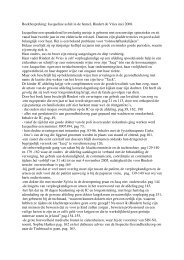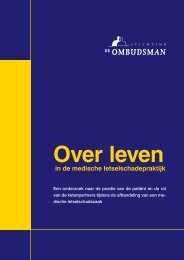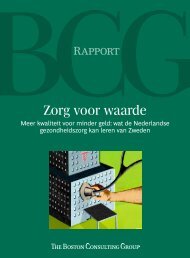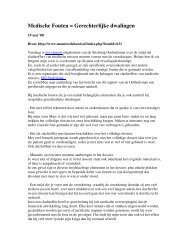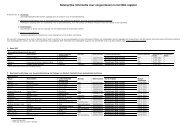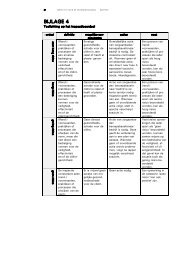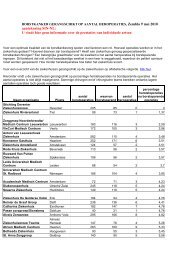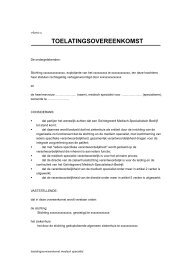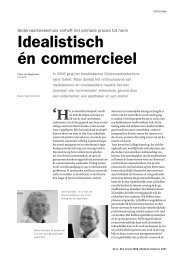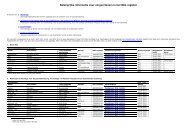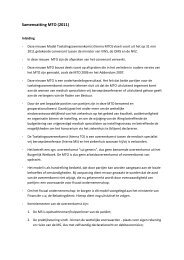- Page 2:
Patiëntveiligheid, de rol van de b
- Page 5 and 6:
Dit proefschrift is goedgekeurd doo
- Page 7 and 8:
InhoudsopgaveHoofdstuk 1 - Inleidin
- Page 10 and 11:
1Hoofdstuk 1Inleiding
- Page 12 and 13:
3 Aandacht verschuift richting vera
- Page 14 and 15:
in een zorgproces dat juist als doe
- Page 16 and 17:
In hoofdstuk 4 wordt toegelicht wat
- Page 18:
Patiëntveiligheid, de rol van de b
- Page 21 and 22:
1 INLEIDINGVolgend op het besluit i
- Page 23 and 24:
Het UMC Utrecht heeft een driekoppi
- Page 25 and 26:
1baar in het tweejaarlijkse Medewer
- Page 27 and 28:
- de invoering van Systematische In
- Page 29 and 30:
etreffende afdelingen is gegaan om
- Page 31 and 32:
leerd. Op basis daarvan wordt een u
- Page 34 and 35:
3Hoofdstuk 3Achtergrond van hetthem
- Page 36 and 37:
To Err Is Human - startschot voor w
- Page 38 and 39:
1984 groeit het aantal van 14 naar
- Page 40 and 41:
Systeemdenken was nieuw voor de zor
- Page 42 and 43:
sigaret staat te roken, wordt hij o
- Page 44 and 45:
werken. Oftewel: wie weet het beter
- Page 46 and 47:
de aanbevelingen was het invoeren v
- Page 48 and 49:
Study en de daaropvolgende Adverse
- Page 50 and 51:
De NTA 8009 was tevens bedoeld als
- Page 52 and 53:
In 2008 is het project “VMS Zorg
- Page 54 and 55:
In het volgende twee hoofdstukken w
- Page 56 and 57:
16 | Act on Patient Safety in the D
- Page 58:
Patiëntveiligheid, de rol van de b
- Page 61 and 62:
1 INTRODUCTIEInleidingIn dit hoofds
- Page 63 and 64:
1234Definitie “patiëntveiligheid
- Page 65 and 66:
patiënt of zijn status te zien. Di
- Page 67 and 68:
het nog beter geweest als ook de sy
- Page 69 and 70:
gevolg relatie is vaak niet duideli
- Page 71 and 72:
10krijgen vanwege de wijze waarop d
- Page 73 and 74:
3 kenmerk patiëntveiligheid: ambig
- Page 75 and 76:
1314that bad people cause bad error
- Page 77 and 78:
art” onderzoeksmethode naar vermi
- Page 79 and 80:
24die de ziekte van Creutzfeld Jaco
- Page 81 and 82:
aanrichten aan patiënten en de org
- Page 83 and 84:
32leiden), de brandveiligheid, de l
- Page 85 and 86:
ehoefte aan efficiencywinst, maar k
- Page 87 and 88:
Functie Ja NeeMedisch specialist 85
- Page 89 and 90:
38ziekenhuis/de arts/de verpleegkun
- Page 91 and 92:
opleider verstoten wordt. Alleen de
- Page 93 and 94:
43de talloze oorzaken waarom een pa
- Page 95:
- enorme variëteit;- variëteit va
- Page 98 and 99:
- grote variëteit;- het raakt de k
- Page 100 and 101:
19 | Zegers M, Hoonhout LH, de Brui
- Page 102:
Patiëntveiligheid, de rol van de b
- Page 105 and 106:
1 patiëntveiligheid, PROFESSIONALS
- Page 107 and 108:
23De Nederlandse gezondheidszorg be
- Page 109 and 110:
6789het stellen van de juiste diagn
- Page 111 and 112:
12… maakt aansturing noodzakelijk
- Page 113 and 114:
151617, 18Professionele habitat…
- Page 115 and 116:
3 “KWALITEIT VAN ZORG” ALS VOOR
- Page 117 and 118:
252627- effectief zijn;- efficiënt
- Page 119 and 120:
2829Kwaliteit wordt bepaald vanuit
- Page 121 and 122:
overtuiging: De patiënt kan het va
- Page 123 and 124:
31noodzaak tot kostenbeheersing. In
- Page 125 and 126:
32Tabel 2: Ongestructureerde proble
- Page 127 and 128:
37kan echter op een andere plek onw
- Page 129 and 130:
Projectmatige sturing leidt bij ong
- Page 131 and 132:
nals. Er is binnen deze samenwerkin
- Page 133 and 134:
aansturingsvormen maken het de orga
- Page 135 and 136:
Tabel 3: Het toepassen van sturings
- Page 137 and 138:
5657InhoudEen risico van bovenstaan
- Page 139 and 140:
Zowel inhoudelijke, hiërarchische
- Page 141 and 142:
met de belemmeringen die het aanstu
- Page 143 and 144:
19 | Bruijn H de. Managers en profe
- Page 146 and 147:
6Hoofdstuk 6MeldingscommissieIncide
- Page 148 and 149:
De werkwijze van de MIP verschilt t
- Page 150 and 151:
ander zegt: “maar dat wás helema
- Page 152 and 153:
echter niet haalbaar. Wanneer een m
- Page 154 and 155:
alle parkeerplaatsen voor medewerke
- Page 156 and 157:
aan de MIP de melder ontslaat van v
- Page 158 and 159:
ingevoerd waardoor een ander niet e
- Page 160 and 161:
woorden. De leidinggevenden hebben
- Page 162 and 163:
eerste melder de correspondentie va
- Page 164 and 165:
domeinnamen met het woord “patië
- Page 166 and 167:
had ongeveer 60 afdelingen en het z
- Page 168 and 169:
veilig meldsysteem geen afbreuk doe
- Page 170 and 171:
het functioneren van de MIP en daar
- Page 172 and 173:
meldingen door artsen toenam. Een a
- Page 174 and 175:
Vragenlijst zette aan tot denkenVoo
- Page 176 and 177:
Bemensing en herkenbaarheid MIPMIP
- Page 178 and 179:
Begrippenkader kerncommissie:Veilig
- Page 180 and 181:
het bestraffen van de betrokken med
- Page 182 and 183:
Tabel 3: Gebruikte strategieën om
- Page 184 and 185:
Belemmerende factorenAls voorbeeldf
- Page 186 and 187:
van de MIP commissie aan het woord
- Page 188 and 189:
leiding vrijheidsgraden waardoor de
- Page 190 and 191:
Gevoel van urgentie op niveau melde
- Page 192 and 193:
edelijk termijn tot een uitkomst te
- Page 194 and 195:
Noten bij hoofdstuk 61 | UMC Utrech
- Page 196:
Patiëntveiligheid, de rol van de b
- Page 199 and 200:
1 INLEIDINGToelichting hoofdstukIn
- Page 201 and 202:
kunnen leiden tot schade. Ook kunne
- Page 203 and 204:
eigen handelen en heeft dit niet in
- Page 205 and 206:
patiënt gaf zelf niet aan dat dit
- Page 207 and 208:
groep om bacteriële infecties te v
- Page 209 and 210:
3 DE IMPLEMENTATIE VAN SIREDe imple
- Page 211 and 212:
medisch specialist, 7 verpleegkundi
- Page 213 and 214:
dat ze de centrale ondersteuning er
- Page 215 and 216:
2 Informatie ordenenDe onderzoeker
- Page 217 and 218:
Het omgaan met de aanbevelingenHet
- Page 219 and 220:
Bestuur kon professionals niet dwin
- Page 221 and 222:
In april 2007 kwam de eerste editie
- Page 223 and 224:
esloot dat zij zouden adviseren om
- Page 225 and 226:
vonden. De meeste medewerkers gaven
- Page 227 and 228:
Structuur rapportage gaf ruimte voo
- Page 229 and 230:
De aandacht voor incidentanalyse is
- Page 231 and 232:
Belemmerende factorenDe methode wor
- Page 233 and 234:
Elk deeltraject kende een eigen pro
- Page 235 and 236:
Kerncommissie, de MIP, de SIRE onde
- Page 237 and 238:
Deelname was veiligBescherming van
- Page 239 and 240:
prikkelend voor de deelnemers en ve
- Page 241 and 242:
Noten bij hoofdstuk 71 | Bagian JP,
- Page 244 and 245:
8Hoofdstuk 8Scenario Analyse vanFaa
- Page 246 and 247:
Bij de ontwikkeling van het project
- Page 248 and 249:
2 WAAROM HET INGEWIKKELD ISInleidin
- Page 250 and 251:
apport krijgt kan zich verplicht vo
- Page 252 and 253:
of dat ze onhaalbaar zijn (bijvoorb
- Page 254 and 255:
werk zo goed mogelijk doen maar er
- Page 256 and 257:
eigen professie onder controle kunn
- Page 258 and 259:
ief”, het officiële document waa
- Page 260 and 261:
de uitvoerbaarheid van een SAFER. B
- Page 262 and 263:
Vooraf werd erkend dat het effect v
- Page 264 and 265:
4 DE DOORWERKING VAN SAFERDe uitvoe
- Page 266 and 267:
professionals die dagelijks te make
- Page 268 and 269:
weerstanden tegen SAFER en de forse
- Page 270 and 271:
Het groepsproces voorkwam dat er te
- Page 272 and 273:
fessionals van verschillende discip
- Page 274 and 275:
Tijdens de evaluatie bleek dat het
- Page 276 and 277:
Tabel 1: Gebruikte strategieën om
- Page 278 and 279:
Invoering vond plaats in deeltrajec
- Page 280 and 281:
SAFER teamleden werden gestimuleerd
- Page 282 and 283:
Besluitvorming tijdens deelprocesse
- Page 284 and 285:
de Raad van Bestuur. Doordat SAFER
- Page 286 and 287:
desondanks tot uitkomsten te komen
- Page 288 and 289:
teveel naar zijn eigen hand zou zet
- Page 290:
Noten bij hoofdstuk 81 | DeRosier J
- Page 293 and 294:
1 DE STRATEGIEËN DIE BIJ DE DRIE C
- Page 295 and 296:
om de ambiguïteit of de variëteit
- Page 297 and 298:
Tabel 1: Voorbeelden van de wijze w
- Page 299 and 300:
Tabel 3: Theoretische noties met be
- Page 301 and 302:
MIP SIRE SAFERVrijwilligheid vandee
- Page 303 and 304:
MIP SIRE SAFERDe verplichting totde
- Page 305 and 306:
MIP SIRE SAFERRuimte voorverschille
- Page 307 and 308:
Tabel 4: Empirische bevindingen die
- Page 309 and 310:
van het proces wel inhoudelijk te v
- Page 311 and 312:
Zo konden de professionals zich erv
- Page 313 and 314:
Inbreng van professionals leidde to
- Page 315 and 316:
werd bedreigd. Het moest voor manag
- Page 317 and 318:
- De deelnemers hadden een exit-opt
- Page 319 and 320:
nemen of dat er een beslissing werd
- Page 321 and 322:
sten af te ronden, omdat dit van he
- Page 323 and 324:
meerdere strategieën genoemd die w
- Page 325 and 326:
etrekking tot patiëntveiligheid, v
- Page 327 and 328:
van de medewerkers die een SIRE had
- Page 329 and 330:
- Initiatiefnemer is bij voorbaat v
- Page 331 and 332:
3 SamenvattingDit onderzoek richt z
- Page 333 and 334: alleen in de juiste onderlinge verh
- Page 335 and 336: 4 BeschouwingInleidingIn de vorige
- Page 337 and 338: ken die aan onveiligheid bijdroegen
- Page 339 and 340: Nuancering van de rol van processtu
- Page 341 and 342: de uitkomsten van dit onderzoek gen
- Page 343 and 344: • In dit onderzoek is gebleken da
- Page 346 and 347: Appendix AReferentiesSamenvattingSu
- Page 348 and 349: 1. Inleiding1.1 Voorgeschiedenis st
- Page 350 and 351: instellen van een Kerncommissie Pat
- Page 352 and 353: 2.4 UitwerkingEr moet één centraa
- Page 354 and 355: - Patiënten Service/ klachtenburea
- Page 356 and 357: Haar taken zijn:1 Het gevraagd en o
- Page 358 and 359: maatschappij kunnen behouden zonder
- Page 360 and 361: 6 Samenstelling Kerncommissie Pati
- Page 362 and 363: - Billings CE. The NASA Aviation Sa
- Page 364 and 365: - Evans RG, Cardiff K, Sheps S. Hig
- Page 366 and 367: - Linkin DR, Sausman C, Santos L, L
- Page 368 and 369: - Stolper E, van Bokhoven M, Houben
- Page 370 and 371: - Zwart DLM, van Rensen ELJ, Verhei
- Page 372 and 373: 3 Prescriptief- Hoe kunnen de uitko
- Page 374 and 375: en dus veilige, zorg te organiseren
- Page 376 and 377: Elke casus bestond uit een aantal o
- Page 378 and 379: ling op de bestaande theorie over p
- Page 380 and 381: - Inbreng;(alle betrokkenen moeten
- Page 382 and 383: 3 Prescriptive- How can the results
- Page 386 and 387: - Root Cause Analysis (RCA), a meth
- Page 388 and 389: ing networks, writing reports) so t
- Page 390 and 391: Dankwoord- Allereerst wil ik mij pr
- Page 392 and 393: - De levenshouding die ertoe geleid
- Page 394 and 395: PublicatielijstPublicaties - boeken
- Page 396: Patiëntveiligheid, de rol van de b



